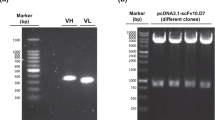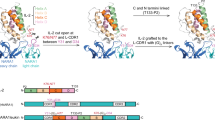Abstract
Antiangiogenic immunotherapy benefits from targeting antigens expressed on genetically stable endothelial cells and represents a novel modality for cancer treatment. Vascular endothelial growth factor (VEGF) receptor 2 (VEGFR2, also known as flk1 in mouse) mediated VEGF signaling is the key rate-limiting step in angiogenesis. Blockade of the flk1 signaling pathway can significantly inhibit tumor cell-induced angiogenesis and lead to inhibition of tumor metastasis. Interferon-gamma (IFN-γ) is a pleiotropic cytokine, which plays an important role in cell-mediated immunity. In this study, we tested the hypothesis that immunization of mice with soluble flk1 (sflk1) and IFN-γ fusion gene-transfected dendritic cells (DC-sflk1-IFN-γ) would induce a potent CTL response to flk1, leading to an inhibition of tumor-induced angiogenesis and metastasis. Our data show that immunization of mice with sflk1 gene-modified DC (DC-sflk1) could induce a CTL response to flk1, leading to profound inhibition of tumor-cell-induced angiogenesis and metastasis. However, more striking antimetastatic effects were achieved through induction of enhanced CTL response to flk1 and augmented inhibition of angiogenesis when mice were immunized with DC-sflk1-IFN-γ. In vivo T-cell subset depletion experiments showed that CD8+ T cells were mainly responsible for this antimetastatic effect. Our data extend the notion that DC-based active antiangiogenic immunotherapy is an effective modality for cancer treatment, and show that the antitumor efficacy of this strategy can be improved by combination with DC-based cytokine immunotherapy.
This is a preview of subscription content, access via your institution
Access options
Subscribe to this journal
Receive 12 print issues and online access
$259.00 per year
only $21.58 per issue
Buy this article
- Purchase on Springer Link
- Instant access to full article PDF
Prices may be subject to local taxes which are calculated during checkout







Similar content being viewed by others
References
Ferrara N . VEGF and the quest for tumour angiogenesis factors. Nat Rev Cancer 2002; 2: 795–803.
Ferrara N, Gerber HP, LeCouter J . The biology of VEGF and its receptors. Nat Med 2003; 6: 669–676.
Hanahan D, Folkman J . Patterns and emerging mechanisms of the angiogenic switch during tumorigenesis. Cell 1996; 86: 353–364.
Cross MJ, Claesson-Welsh L . FGF and VEGF function in angiogenesis: signalling pathways, biological responses and therapeutic inhibition. Trends Pharmacol Sci 2001; 22: 201–207.
Dias S et al. Autocrine stimulation of VEGFR-2 activates human leukemic cell growth and migration. J Clin Invest 2000; 106: 511–521.
Veikkola T, Karkkainen M, Claesson-Welsh L, Alitalo K . Regulation of angiogenesis via vascular endothelial growth factor receptors. Cancer Res 2000; 60: 203–212.
Tseng JF et al. Adenovirus-mediated delivery of a soluble form of the VEGF receptor Flk1 delays the growth of murine and human pancreatic adenocarcinoma in mice. Surgery 2002; 132: 857–865.
Inoue K et al. Treatment of human metastatic transitional cell carcinoma of the bladder in a murine model with the anti-vascular endothelial growth factor receptor monoclonal antibody DC101 and paclitaxel. Clin Cancer Res 2000; 6: 2635–2643.
Wei YQ et al. Immunotherapy of tumors with xenogeneic endothelial cells as a vaccine. Nat Med 2000; 6: 1160–1166.
Niethammer AG et al. A DNA vaccine against VEGF receptor 2 prevents effective angiogenesis and inhibits tumor growth. Nat Med 2002; 8: 1369–1375.
Li Y et al. Active immunization against the vascular endothelial growth factor receptor flk1 inhibits tumor angiogenesis and metastasis. J Exp Med 2002; 195: 1575–1584.
Nair S et al. Synergy between tumor immunotherapy and antiangiogenic therapy. Blood 2003; 102: 964–971.
Boehm U, Klamp T, Groot M, Howard JC . Cellular responses to interferon-gamma. Annu Rev Immunol 1997; 15: 749–795.
Fruh K, Yang Y . Antigen presentation by MHC class I and its regulation by interferon gamma. Curr Opin Immunol 1999; 11: 76–81.
Shankaran V et al. IFNgamma and lymphocytes prevent primary tumour development and shape tumour immunogenicity. Nature 2001; 410: 1107–1111.
Waldmann TA . Immunotherapy: past, present and future. Nat Med 2003; 9: 269–277.
Vieira PL et al. Development of Th1-inducing capacity in myeloid dendritic cells requires environmental instruction. J Immunol 2000; 164: 4507–4512.
Pan J et al. Interferon-γ is an autocrine mediator for dendritic cell maturation. Immunol Lett 2004; 94: 141–151.
Tannenbaum CS, Hamilton TA . Immune-inflammatory mechanisms in IFNgamma-mediated anti-tumor activity. Semin Cancer Biol 2000; 10: 113–123.
Kawano Y et al. Effects of interferon-gamma on secretion of vascular endothelial growth factor by endometrial stromal cells. Am J Reprod Immunol 2000; 43: 47–52.
Fukao T, Matsuda S, Koyasu S . Synergistic effects of IL-4 and IL-18 on IL-12-dependent IFN-gamma production by dendritic cells. J Immunol 2000; 164: 64–71.
Ohteki T et al. Interleukin 12-dependent interferon gamma production by CD8alpha+ lymphoid dendritic cells. J Exp Med 1999; 189: 1981–1986.
Hoffmann J, Schirner M, Menrad A, Schneider MR . A highly sensitive model for quantification of in vivo tumor angiogenesis induced by alginate-encapsulated tumor cells. Cancer Res 1997; 57: 3847–3851.
Pardoll DM . Spinning molecular immunology into successful immunotherapy. Nat Rev Immunol 2002; 2: 227–238.
Shimizu K, Thomas EK, Giedlin M, Mule JJ . Enhancement of tumor lysate- and peptide-pulsed dendritic cell-based vaccines by the addition of foreign helper protein. Cancer Res 2001; 61: 2618–2624.
Srivastava PK . Immunotherapy of human cancer: lessons from mice. Nat Immunol 2000; 1: 363–366.
Srivastava P . Roles of heat-shock proteins in innate and adaptive immunity. Nat Rev Immunol 2002; 2: 185–194.
Ito T et al. Differential regulation of human blood dendritic cell subsets by IFNs. J Immunol 2001; 166: 2961–2969.
Mosca PJ et al. A subset of human monocyte-derived dendritic cells expresses high levels of interleukin-12 in response to combined CD40 ligand and interferon-gamma treatment. Blood 2000; 96: 3499–3504.
Koski GK, Lyakh LA, Rice NR . Rapid lipopolysaccharide-induced differentiation of CD14(+) monocytes into CD83(+) dendritic cells is modulated under serum-free conditions by exogenously added IFN-gamma and endogenously produced IL-10. Eur J Immunol 2001; 31: 3773–3781.
Akbar SM et al. Unique features of dendritic cells in IFN-gamma transgenic mice: relevance to cancer development and therapeutic implications. Biochem Biophys Res Commun 1999; 259: 294–299.
Dubois S, Mariner J, Waldmann TA, Tagaya Y . IL-15Ralpha recycles and presents IL-15 in trans to neighboring cells. Immunity 2002; 17: 537–547.
Zeis M et al. Generation of cytotoxic responses in mice and human individuals against hematological malignancies using survivin-RNA-transfected dendritic cells. J Immunol 2003; 170: 5391–5397.
Van Tendeloo VF et al. Nonviral transfection of distinct types of human dendritic cells: high-efficiency gene transfer by electroporation into hematopoietic progenitor- but not monocyte-derived dendritic cells. Gene Therapy 1998; 5: 700–707.
Fields RC, Shimizu K, Mule JJ . Murine dendritic cells pulsed with whole tumor lysates mediate potent antitumor immune responses in vitro and in vivo. Proc Natl Acad Sci USA 1998; 95: 9482–9487.
Acknowledgements
Dr J Pan was supported as a guest scientist of the SFB 415 of the Deutsche Forschungsgemeinschaft. We would like to thank Dr A Vecchi (Instituto Mario Negri, Milan, Italy) for providing the endothelial cell line H5V and Dr GJ Hämmerling (Division of Molecular Immunology, German Cancer Research Center, Heidelberg, Germany) for providing the Lewis lung carcinoma cell line D122.8. We also thank Dr M Kosmahl (Institute of Pathology, Universitätsklinikum Schleswig-Holstein Campus Kiel, Kiel, Germany) for his help in histological analysis.
Author information
Authors and Affiliations
Rights and permissions
About this article
Cite this article
Pan, J., Heiser, A., Marget, M. et al. Enhanced antimetastatic effect of fetal liver kinase 1 extracellular domain and interferon-gamma fusion gene-modified dendritic cell vaccination. Gene Ther 12, 742–750 (2005). https://doi.org/10.1038/sj.gt.3302470
Received:
Accepted:
Published:
Issue Date:
DOI: https://doi.org/10.1038/sj.gt.3302470
Keywords
This article is cited by
-
Anti-tumoral effect of active immunotherapy in C57BL/6 mice using a recombinant human VEGF protein as antigen and three chemically unrelated adjuvants
Angiogenesis (2008)
-
Anti-angiogenic active immunotherapy: a new approach to cancer treatment
Cancer Immunology, Immunotherapy (2008)
-
Inhibition of angiogenesis by a Semliki Forest virus vector expressing VEGFR-2 reduces tumour growth and metastasis in mice
Gene Therapy (2007)



